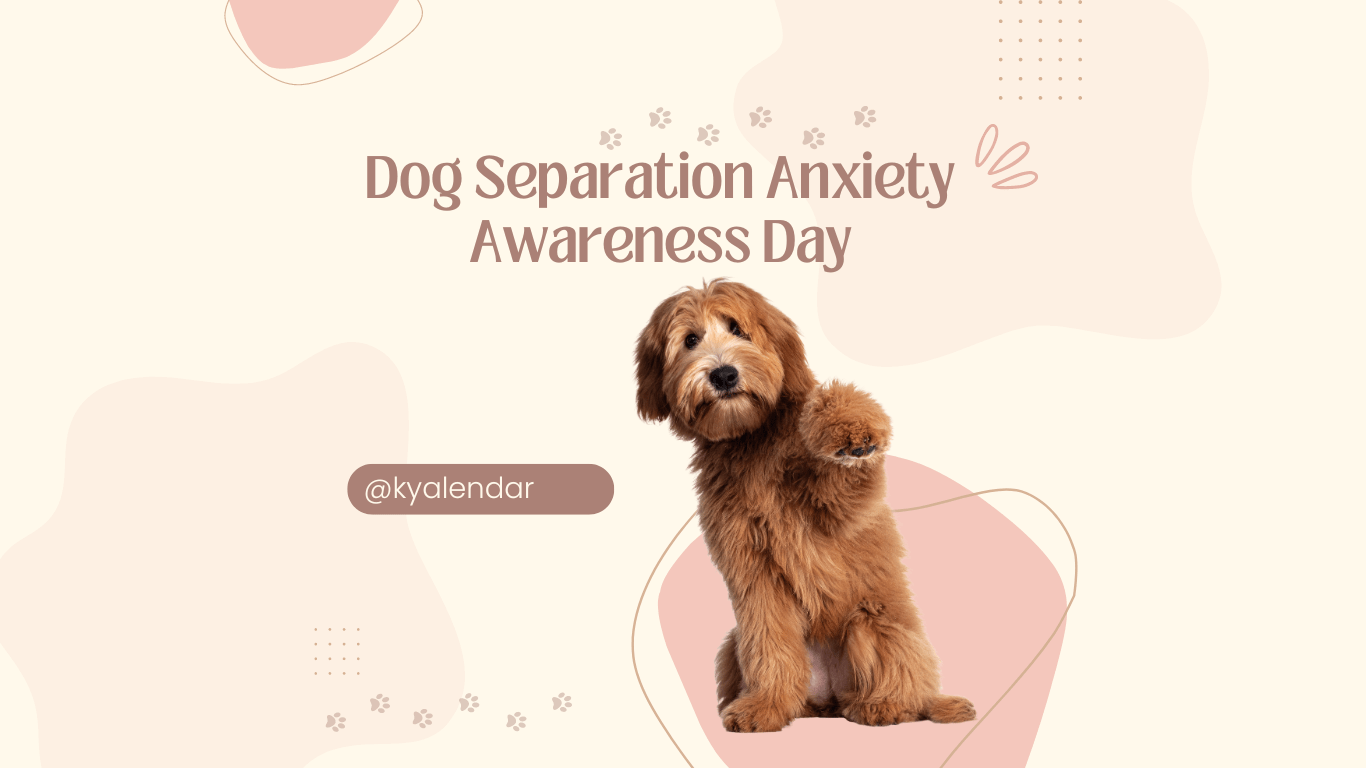
- This event has passed.
Dog Separation Anxiety Awareness Day
September 30

Dog Separation Anxiety Awareness Day, observed annually on September 30th, is dedicated to raising awareness about a common but often misunderstood condition affecting dogs: separation anxiety. This day aims to educate pet owners about the signs, causes, and effective management of separation anxiety, and to highlight the importance of providing appropriate support for affected dogs.
What is Separation Anxiety?
Separation anxiety is a behavioural disorder in dogs that manifests when a dog experiences extreme distress and anxiety when separated from its owner or primary caregiver. This condition is more than just occasional whining or barking when left alone; it involves intense fear and emotional distress that can lead to destructive behaviours and significant stress for both the dog and the owner.
Signs of Separation Anxiety
Recognising the signs of separation anxiety is crucial for early intervention and effective management. Common signs include:
- Excessive Barking or Howling: Dogs with separation anxiety may vocalise excessively when left alone, often barking, whining, or howling for extended periods.
- Destructive Behaviour: Chewing, digging, or scratching at doors, windows, or other areas in an attempt to escape can be signs of separation anxiety. This behaviour is driven by the dog’s distress and attempt to reunite with its owner.
- House Training Issues: Affected dogs may urinate or defecate indoors, even if they are house-trained. This behaviour is typically a result of the stress and anxiety experienced when left alone.
- Pacing and Restlessness: Dogs with separation anxiety often exhibit pacing, restlessness, or repetitive behaviours, such as circling or following their owner around the house.
- Excessive Drooling or Panting: Increased salivation, panting, or other signs of physical distress may accompany the emotional anxiety experienced by the dog.
Causes of Separation Anxiety
Several factors can contribute to the development of separation anxiety in dogs, including:
- Early Life Experiences: Dogs that were separated from their mother or littermates too early or experienced traumatic events during their early life may be more prone to separation anxiety.
- Changes in Routine or Environment: Significant changes, such as moving to a new home, changes in the owner’s schedule, or the loss of a family member or pet, can trigger separation anxiety.
- Lack of Socialisation: Dogs that have not been properly socialised or are not accustomed to being alone for extended periods may develop separation anxiety.
- Genetic Predisposition: Some breeds or individual dogs may be more predisposed to separation anxiety due to their genetic makeup and temperament.
Managing and Treating Separation Anxiety
Effective management and treatment of separation anxiety involve a combination of behaviour modification, training, and environmental adjustments. Here are some strategies to help alleviate separation anxiety in dogs:
- Gradual Desensitisation: Slowly accustom your dog to being alone by gradually increasing the duration of separation in a controlled manner. Start with short periods and gradually extend the time as your dog becomes more comfortable.
- Positive Reinforcement: Reward your dog for calm behaviour when you leave and return home. Use treats, praise, and affection to reinforce positive associations with being alone.
- Create a Safe Space: Provide a comfortable and secure area for your dog with their favourite toys, bedding, and a comforting item, such as an item of your clothing. This safe space can help reduce anxiety when you are not home.
- Establish a Routine: Maintain a consistent daily routine for feeding, exercise, and playtime. Predictable routines can help reduce anxiety and provide a sense of security for your dog.
- Interactive Toys and Enrichment: Use interactive toys, puzzle feeders, and other forms of mental stimulation to keep your dog occupied while you are away. This can help alleviate boredom and reduce anxiety.
- Professional Help: In severe cases, consider seeking the assistance of a professional dog trainer or behaviourist who specialises in separation anxiety. They can provide tailored guidance and support to address your dog’s specific needs.
- Medication: In some cases, medication prescribed by a veterinarian may be necessary to help manage severe separation anxiety. This should be considered as part of a comprehensive treatment plan, alongside behaviour modification techniques.
Promoting Awareness
On Dog Separation Anxiety Awareness Day, pet owners and animal welfare organisations can work together to spread awareness about this important issue. Sharing information through social media, hosting educational events, and providing resources for dog owners can help increase understanding and support for dogs struggling with separation anxiety.
In Conclusion
Dog Separation Anxiety Awareness Day on September 16th is a valuable opportunity to educate pet owners about the signs, causes, and management of separation anxiety. By recognising the symptoms and implementing effective strategies to address this condition, we can improve the quality of life for affected dogs and strengthen the bond between pets and their owners. This day serves as a reminder of the importance of understanding and addressing separation anxiety, and of providing compassionate support to ensure the well-being of our canine companions.